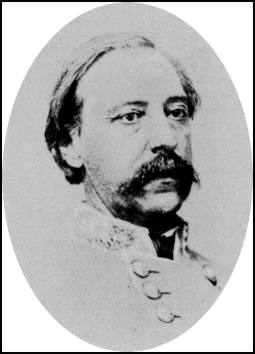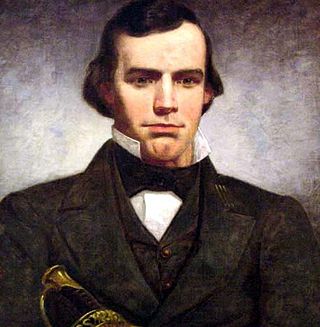Related Research Articles

In the American Civil War (1861–65), the border states were four, later five, slave states that primarily supported the Union. They were Delaware, Maryland, Kentucky, and Missouri, and after 1863, the new state of West Virginia. To their north they bordered free states of the Union, and all but Delaware bordered slave states of the Confederacy to their south.

Milledge Luke Bonham was an American politician and Congressman. He was later the 70th Governor of South Carolina from 1862 until 1864, and a Confederate General during the American Civil War.

John Gregg was an American politician who served as a deputy from Texas to the Provisional Congress of the Confederate States from 1861 to 1862. He served as a brigade commander officer of the Confederate States Army and was killed in action during the Siege of Petersburg.

The U.S. state of West Virginia was formed out of western Virginia and added to the Union as a direct result of the American Civil War, in which it became the only modern state to have declared its independence from the Confederacy. In the summer of 1861, Union troops, which included a number of newly formed Western Virginia regiments, under General George McClellan drove off Confederate troops under General Robert E. Lee at the Battle of Philippi in Barbour County. This essentially freed Unionists in the northwestern counties of Virginia to form a functioning government of their own as a result of the Wheeling Convention. Before the admission of West Virginia as a state, the government in Wheeling formally claimed jurisdiction over all of Virginia, although from its creation it was firmly committed to the formation of a separate state.

Goode Bryan was a planter, politician, military officer, and American Civil War general in the Confederate States Army. His brigade played a prominent role during the Battle of the Wilderness, fighting stubbornly until exhausting its ammunition.

Florida participated in the American Civil War as a member of the Confederate States of America. It had been admitted to the United States as a slave state in 1845. In January 1861, Florida became the third Southern state to secede from the Union after the November 1860 presidential election victory of Abraham Lincoln. It was one of the initial seven slave states which formed the Confederacy on February 8, 1861, in advance of the American Civil War.

The American state of Virginia became a prominent part of the Confederacy when it joined during the American Civil War. As a Southern slave-holding state, Virginia held the state convention to deal with the secession crisis and voted against secession on April 4, 1861. Opinion shifted after the Battle of Fort Sumter on April 12, and April 15, when U.S. President Abraham Lincoln called for troops from all states still in the Union to put down the rebellion. For all practical purposes, Virginia joined the Confederacy on April 17, though secession was not officially ratified until May 23. A Unionist government was established in Wheeling and the new state of West Virginia was created by an act of Congress from 50 counties of western Virginia, making it the only state to lose territory as a consequence of the war. Unionism was indeed strong also in other parts of the State, and during the war the Restored Government of Virginia was created as rival to the Confederate Government of Virginia, making it one of the states to have 2 governments during the Civil War.

During the American Civil War, Arkansas was a Confederate state, though it had initially voted to remain in the Union. Following the capture of Fort Sumter in April 1861, Abraham Lincoln called for troops from every Union state to put down the rebellion, and Arkansas and several other states seceded. For the rest of the civil war, Arkansas played a major role in controlling the Mississippi River, a major waterway.

William Gay Brown Sr. was a nineteenth-century politician and lawyer from Virginia, who was twice elected to the Virginia General Assembly and thrice to the U.S. House of Representatives. He also served at the Virginia Constitutional Convention of 1850 and later opposed secession at the Virginia Secession Convention of 1861. A leading Unconditional Unionist during the American Civil War, he became one of the founders of West Virginia.

The city of Winchester, Virginia, and the surrounding area, were the site of numerous battles during the American Civil War, as contending armies strove to control the lower Shenandoah Valley. Winchester changed hands more often than any other Confederate city.

John James Davis was an American attorney and politician who helped found West Virginia and later served as a United States representative in Congress from that state.

The Confederate government of Kentucky was a shadow government established for the Commonwealth of Kentucky by a self-constituted group of Confederate sympathizers and delegates sent by Kentucky counties, during the American Civil War. The shadow government never replaced the elected government in Frankfort, in which the state legislature had strong Union sympathies while the governor was pro-Confederate. Neither was it able to gain the whole support of Kentucky's citizens; its jurisdiction extended only as far as Confederate battle lines in the Commonwealth, which at its greatest extent in 1861 and early 1862 encompassed over half the state. Nevertheless, the provisional government was recognized by the Confederate States of America, and Kentucky was admitted to the Confederacy on December 10, 1861. Kentucky, the final state admitted to the Confederacy, was represented by the 13th (central) star on the Confederate battle flag.

The RestoredGovernment of Virginia was the Unionist government of Virginia during the American Civil War (1861–1865) in opposition to the government which had approved Virginia's seceding from the United States and joining the new Confederate States of America. Each state government regarded the other as illegitimate. The Restored Government attempted to assume de facto control of the Commonwealth's northwest with the help of the Union Army but was only partly successful. It raised Union regiments from local volunteers but depended upon recruits from Pennsylvania and Ohio to fulfill its commitments. It administered this territory until, with its approval, the area became part of West Virginia in mid-1863.

John Quincy Marr was a Virginia militia company captain and the first Confederate soldier killed by a Union soldier in combat during the American Civil War. Marr was killed at the Battle of Fairfax Court House, Virginia on June 1, 1861. Previously one of Fauquier County's two delegates to the Virginia Secession Convention of 1861, Marr initially opposed his state's secession from the Union but ultimately supported secession, as did voters shortly before his fatal skirmish.

John Lawrence Marye Jr., was a Virginia lawyer, plantation owner, Confederate soldier and politician. He served in the Virginia House of Delegates during the American Civil War, and upon the legislature's election of Lt. Gov. John F. Lewis as one of Virginia's U.S. Senators following the Commonwealth's readmission to the Union, was elected the tenth Lieutenant Governor of Virginia (1870-1874) and as such presided over the Virginia Senate. Marye also represented Spotsylvania County in both the Virginia Secession Convention and the Virginia Constitutional Convention of 1868, when he was a leading opponent of Congressional Reconstruction.
Robert Edwin Cowan was a Virginia lawyer and politician who served in the Virginia House of Delegates and the Virginia Secession Convention of 1861 and as a Confederate officer. After the American Civil War, he moved to Kansas City, Missouri, where he resumed his legal practice and was elected a judge before his death and burial in St. Louis.
Robert E. Grant was a Virginia farmer and dentist who represented Washington County for one term in the Virginia House of Delegates and later at the Virginia Secession Convention of 1861. During the American Civil War, he recruited a company of the 37th Virginia Infantry, but failed to win re-election as captain, and ultimately moved to Texas in 1872 and re-established his practice.
Robert Waterman Hunter was a Virginia newspaper editor and Confederate officer who twice served single terms in the Virginia House of Delegates and became the first Secretary of Virginia Military Records, as well as served as federal Inspector of Public Lands during the first Cleveland administration.
Daniel Edward Frost was an American journalist, politician and soldier who twice served in the Virginia House of Delegates before the American Civil War. He helped found the state of West Virginia at the Wheeling Convention where he represented Jackson County and served as Speaker of the House of Delegates for the Virginia General Assembly at Wheeling, before he died fighting for the Union while leading the 11th West Virginia Infantry Regiment.
On June 20, 1863, the U.S. government created a new state from 50 western counties of Virginia to be named "West Virginia". This was done on behalf of a Unionist government in Wheeling, Virginia, approved by Congress and President Lincoln, though it was done with a low participation of the citizens within the new state. There remained a large number of counties and citizens who still considered themselves as part of Virginia and the Confederacy which, in turn, considered the new state as part of Virginia and the Confederacy. In 1861 the 50 counties contained a population of 355,544 whites, 2,782 freemen, 18,371 slaves, 79,515 voters and 67,721 men of military age. West Virginia was the 6th most contested state during the war, with 632 battles, engagements, actions and skirmishes.
References
- 1 2 "How Virginia Convention Delegates Voted on Secession, April 4 and April 17, 1861, and Whether They Signed a Copy of the Ordinance of Secession" (PDF). Library of Virginia. Archived (PDF) from the original on 27 May 2019. Retrieved 23 May 2021.
- 1 2 3 Snyder, Dorothy B. (21 May 2003). "Reliving Lives: Prestonians and the Civil War". Preston County Journal . Kingwood, West Virginia. p. 8.
A Glimpse into Preston County During the Spring of 1861: Seizure of Arms
- ↑ The Southeastern Reporter, vol. 46, Saint Paul, Minnesota: West Publishing, 1904, pp. 582–589
- 1 2 3 4 Armstrong, Richard L. (1990). "Combined Roster". 25th Virginia Infantry and 9th Battalion Virginia Infantry (1st ed.). Lynchburg, Virginia: H. E. Howard. p. 148. ISBN 1-56190-007-9.
- ↑ Leonard, Cynthia Miller (1978). "The General Assembly". The General Assembly of Virginia July 30, 1619–January 11, 1978: A Bicentennial Register of Members. Richmond, Virginia: Virginia State Library. pp. 483–488. ISBN 0-88490-008-8.